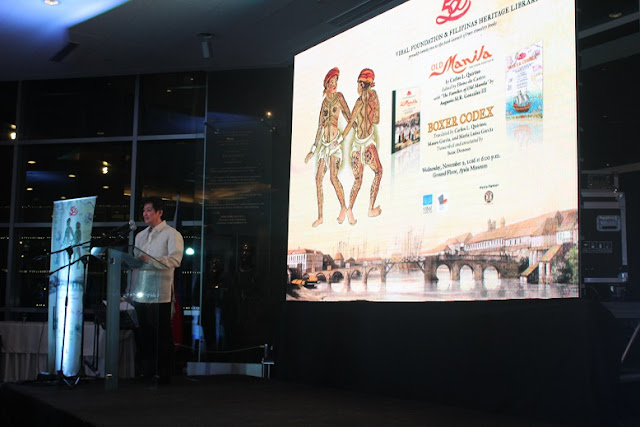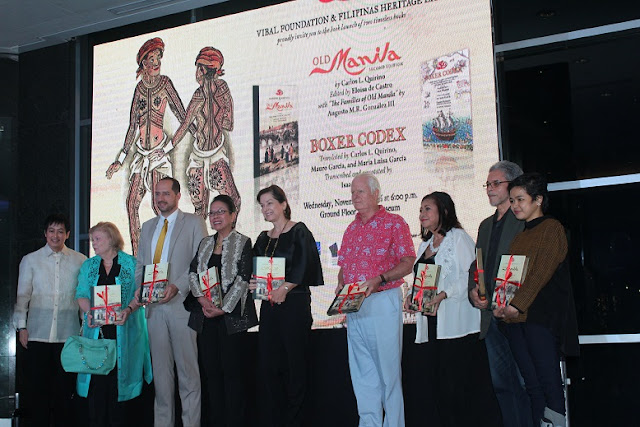I couldn't remember the last time I have been to Ayala Museum. I knew I am a frequent visitor to places that showcase the history and culture of our country back when I was new in blogging. I have been to so many history talks from National Museum, to Intramuros to Instituto Cervantes de Manila. I am a proud heritage buff in my own way. When I decided to focus primarily to travel, my visits to museums dwindled a little bit that is why I am glad to see it one more time during the launching of National Artist Carlos Quirino's Boxer Codex book by Vibal Foundation Inc.
“It is important to have a deep appreciation of our history,” says Vibal Group’s President and CEO Gaspar Vibal. “These stories, told through pictures, depictions, and maps, are what binds our country together as a nation. These two books of the National Artist Carlos Quirino have become timeless classics that much-loved references in their fields.”
What is Boxer Codex?
Initially acquired by British scholar Professor Charles F. Boxer in 1947, the Boxer Codex is a manuscript containing vivid depictions and several eyewitness accounts of both Spanish and Portuguese expeditions in east and southeast Asia, particularly the Philippines. The codex is currently housed at the Lilly Library of Indiana University in Indiana, US.
Most of the illustrations in the book depict the archipelago inhabitants, from the Tagalog maginoos to Zambal warriors. Vibal’s version of the Boxer Codex is a bilingual transcription in modern Spanish in English that is accompanied with an English translation by Quirino. Edited and transcribed by Isaac Donoso, this edition makes the entire codex accessible to Filipinos. Additional translations and annotations have been provided by Ma. Luisa Garcia.
This landmark translation of the entire manuscript marks the kickoff of the commemoration of 500 years of Philippine and Spanish encounters from 1521 to 2021. A limited run of one hundred advanced copies of the Boxer Codex were sold out within two hours at the recently concluded 37th Manila International Book Fair at SMX Convention Center, SM Mall of Asia, Pasay.
Old Manila, 2nd edition
While the Boxer Codex depicts the Filipinos during early Spanish contact, Old Manila shifts its focus to the center of Philippine colonial history. The book details the fascinating history of Manila, from its foundation to the historic Battle of Manila Bay, when “old Manila came to an end.”
Building on the first edition published in 1971 during the observation of Manila’s fourth centenary, this new edition contains the original text with enriched visuals—maps, postcards, engravings, sketches, and photographs—making it a comprehensive pictorial and historical record of Manila and its denizens through the centuries. It also incorporates essays providing different lenses and perspectives for readers to easily imagine and appreciate Manila in the past.
No mere chronology, the book addresses a wide range of urgan themes, such as religion, theater, war, food, pestilence, immigration, crime and punishment, business, art, and the old families who are intimately connected with the history of the ever distinguished and noble city.
For orders and sales inquiries, please email marketing@vibalgroup.com or contact Vibal Group, Inc. through 580-7400 loc 402.
About the Publisher
For 63 years now, the name Vibal has become synonymous with high-quality educational materials for Filipino students. However, we recognize that to push through with our vision, that is to make Filipinos more intelligent with books and technology, we need to further the discussion on Philippine history and culture through books and Web sites that captivate both the mind and the eye.
“It is important to have a deep appreciation of our history,” says Vibal Group’s President and CEO Gaspar Vibal. “These stories, told through pictures, depictions, and maps, are what binds our country together as a nation. These two books of the National Artist Carlos Quirino have become timeless classics that much-loved references in their fields.”
What is Boxer Codex?
Initially acquired by British scholar Professor Charles F. Boxer in 1947, the Boxer Codex is a manuscript containing vivid depictions and several eyewitness accounts of both Spanish and Portuguese expeditions in east and southeast Asia, particularly the Philippines. The codex is currently housed at the Lilly Library of Indiana University in Indiana, US.
Most of the illustrations in the book depict the archipelago inhabitants, from the Tagalog maginoos to Zambal warriors. Vibal’s version of the Boxer Codex is a bilingual transcription in modern Spanish in English that is accompanied with an English translation by Quirino. Edited and transcribed by Isaac Donoso, this edition makes the entire codex accessible to Filipinos. Additional translations and annotations have been provided by Ma. Luisa Garcia.
This landmark translation of the entire manuscript marks the kickoff of the commemoration of 500 years of Philippine and Spanish encounters from 1521 to 2021. A limited run of one hundred advanced copies of the Boxer Codex were sold out within two hours at the recently concluded 37th Manila International Book Fair at SMX Convention Center, SM Mall of Asia, Pasay.
Old Manila, 2nd edition
While the Boxer Codex depicts the Filipinos during early Spanish contact, Old Manila shifts its focus to the center of Philippine colonial history. The book details the fascinating history of Manila, from its foundation to the historic Battle of Manila Bay, when “old Manila came to an end.”
Building on the first edition published in 1971 during the observation of Manila’s fourth centenary, this new edition contains the original text with enriched visuals—maps, postcards, engravings, sketches, and photographs—making it a comprehensive pictorial and historical record of Manila and its denizens through the centuries. It also incorporates essays providing different lenses and perspectives for readers to easily imagine and appreciate Manila in the past.
No mere chronology, the book addresses a wide range of urgan themes, such as religion, theater, war, food, pestilence, immigration, crime and punishment, business, art, and the old families who are intimately connected with the history of the ever distinguished and noble city.
Around 150 people (publishers, professors, historians, writers, artists, government representatives, and other personalities) joined that night. I even met a professor all the way from Albay, my province who just came to Manila to celebrate this book launching. I have learned so much about Carlos Quirino in this talk other than what he is as one of the country's National Artist. He is a role model to all and even to the millenials of today.
For orders and sales inquiries, please email marketing@vibalgroup.com or contact Vibal Group, Inc. through 580-7400 loc 402.
About the Publisher
For 63 years now, the name Vibal has become synonymous with high-quality educational materials for Filipino students. However, we recognize that to push through with our vision, that is to make Filipinos more intelligent with books and technology, we need to further the discussion on Philippine history and culture through books and Web sites that captivate both the mind and the eye.





No comments